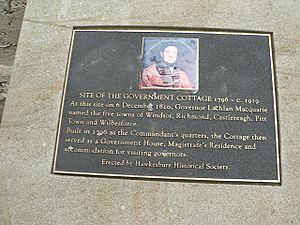Government Cottage Archaeological Site facts for kids
Quick facts for kids Government Cottage Archaeological Site |
|
|---|---|

Plaque marking the site
|
|
| Location | 41 George Street, Windsor, City of Hawkesbury, New South Wales, Australia |
| Built | 1796–1815 |
| Official name: Government Cottage Archaeological Site; Commandant's House; Government House | |
| Type | state heritage (archaeological-terrestrial) |
| Designated | 4 February 2011 |
| Reference no. | 1843 |
| Type | Government House |
| Category | Government and Administration |
| Lua error in Module:Location_map at line 420: attempt to index field 'wikibase' (a nil value). | |
The Government Cottage Archaeological Site is a very old and important historical spot in Windsor, Australia. It's where a special cottage once stood. This cottage was used for different important jobs. Sometimes it was the home for the person in charge of the Hawkesbury area's military (called the commandant). Other times, it was where the local judge lived. It even served as a temporary home for the Governor of New South Wales when he visited the area.
The original cottage was built between 1796 and 1815. It was later taken down around 1920-21. Today, you can find it at 41 George Street in Windsor. This site is also known as the Commandant's House or Government House. It was officially added to the New South Wales State Heritage Register on February 4, 2011, because of its historical importance.
Contents
What Was Government Cottage?
The Government Cottage was not just a house; it was a symbol of government presence in the early days of the Colony of New South Wales. It showed that the government and military were in control of the Hawkesbury district.
Building and Changes
The cottage was built over several years, starting in 1796. It was finished around 1815. Over time, it had some changes and repairs.
- Around 1806-07, the roof and floor were fixed. Two new rooms were added.
- Between 1811 and 1815, more repairs and improvements were made.
- The building was eventually taken down around 1920-21.
- A new building was built on the same spot in the early 1920s.
Who Lived and Worked There?
Many important people were connected to the Government Cottage. It was the home and workplace for the military leaders of the Hawkesbury. These leaders were called Commandants. Some of them included Abbott, McKellar, Fenn Kemp, and Hobby.
The cottage was also linked to several early Governors of New South Wales. These included Governor Hunter, Governor King, Governor Bligh, and especially Governor Macquarie.
Why Is This Site Important Today?
The Government Cottage Archaeological Site is very important for understanding the history of New South Wales. It helps us learn about how the Hawkesbury district first developed.
A Place of Early Government
This site shows us where one of the earliest government buildings outside of Sydney was located. It was a key place for civil control in the Hawkesbury area between 1795 and 1810. This means it was the center of government for the settlement.
Governor Macquarie's Base
The site is especially important because of its connection to Governor Macquarie. He used the cottage as his base when he traveled around the Hawkesbury District. From here, he planned and marked out the locations for five important towns. These towns are Windsor, Richmond, Wilberforce, Castlereagh, and Pitt Town. These are known as the Macquarie Towns.
Amazing Views
The site offers beautiful views of the Hawkesbury River and the floodplains. These views were noticed as early as 1810. The cottage was built in a high spot. This allowed the commandant to watch over the new settlement. Visitors often commented on the beauty of the area.
Discovering the Past
Even though the cottage is gone, there are still things buried underground. These are called archaeological deposits and features. They are like clues from the past.
- These clues can tell us about one of the first public buildings built outside of Sydney.
- They can also show how the building was changed and used for different purposes over time.
- Finding these remains helps us understand the early history of the colony.
This archaeological site is quite rare. It's one of the very first government cottages built outside of Sydney. Its main purpose wasn't just to house someone in charge of convicts. This makes it a unique part of New South Wales's history.

